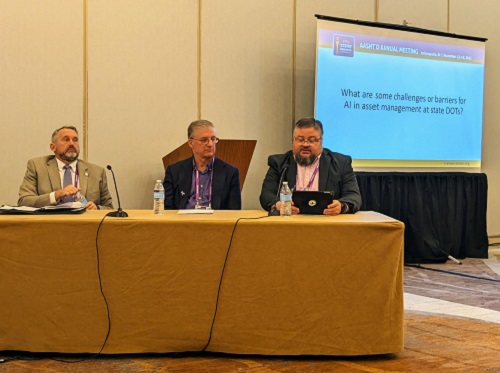The American Association of State Highway and Transportation Officials hosted a knowledge session on how artificial intelligence or AI will impact infrastructure asset management at its 2023 Annual Meeting in Indianapolis.
[Above photo by AASHTO]
“We are living in a world of constant change and now we are about to get a high octane boost from AI,” explained Steve Ross, chief information officer for EXP, the session moderator. “AI is going to become more a part of everything we do – and as a result the tools we use on a day-to-day basis in transportation are going to inherit tremendous capabilities. We may see 10 years of advancement in the next 12 to 18 months.”
Chris Peoples, chief operating officer for the North Carolina Department of Transportation, said that while he is not an expert on AI – “I do not even know how to define AI” –he is looking for every tool he can find to do that as efficiently as possible, as he is trying to run a very large organization.

“How might AI help us deliver projects in a more cost effective way? Also imagine a machine that captures all the statewide data in a consistent fashion about all of our assets,” he said. “Then we can take the human labor resources used on those tasks and apply them for something else.”
He said it is also about using AI to ask the right questions about a state DOT’s ability to make it more effective. “I don’t care how many people you have; you don’t have enough to analyze all the data you have,” Peoples noted. “You will also save time not only having AI analyze data but also ignoring data you don’t need.”
Yet Matthew Haubrich, transportation asset management administrator for the Iowa Department of Transportation, stressed that it is important to recognize that AI is not “all powerful” and relies on good data to make good decisions.
“These [AI] tools can truly be transformative, but they need solid business rules built around them,” he said. “My point of view is that all data contains bias – it is important to understand bias exists in the data. It may look like a neutral third party, but AI really reflects current data bias. Need to be really conscious of that the bias in the data.”
For that reason, Haubrich said the “really critical point” is that, as state DOTs see the future coming with AI, they are aware of the risk factors, of its fallibilities, and not be too dazzled by it.
“AI can be a tremendous to help us if our business processes are properly aligned with it, but we are nowhere near the point where we will turn over asset decisions to AI,” he pointed out. “We are not even close to the point where it will make decisions for us.”
However, Louis Feagans – the managing director of system performance and transportation policy for the Indiana Department of Transportation – said the key benefit offered by AI in the here and now is its ability to let state DOTs optimize their project delivery programs at a far faster pace.
“It is about letting the machine build a project, which you then modify based on your field experience,” he explained. “Data governance is critical to this. You have to have the business aspects set to guide what the program is going to do – you need business rules and a proper mindset. If you do not, that is where you get into problems.”
The key with AI is that it can crunch thousands upon thousands of data points in minutes versus the days or weeks required by past human-driven processes, Feagans said.
“In the end, AI helps you keep your engineers and personnel out in the field, not in the office looking at spreadsheets,” he noted.
 Nation
Nation
The State DOT Role in Safer Land Use Decisions
October 31, 2025 Nation
Nation

